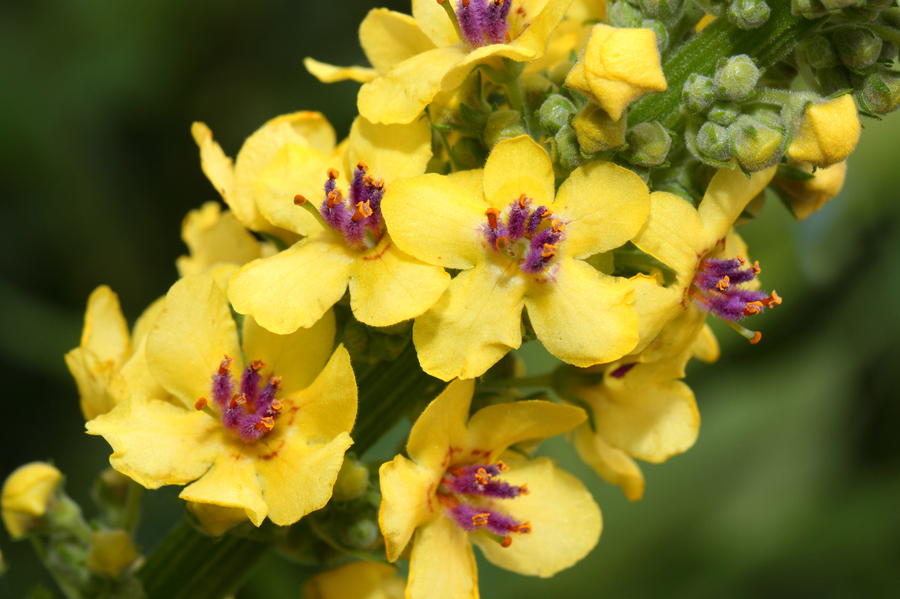Flowering perennial and annual plants offers exquisite blooms for the gardens and interiors in the most vivid colors. They display brightly colored flowers from mid-spring to fall, attracting butterflies, hummingbirds, and honey bees to small home gardens.
In addition, these flowering plants accentuate the cottage and Mediterranean-style garden themes. In this article, we’ll cover 13 breathtaking flowers that start with V to add to your garden and interior spaces.
List of Flowers that Start With V
Perennial Flowers that Start with V
- Valerian (Valeriana officinalis)
- Veronica (Veronica spp.)
- Vetch (Vicia spp.)
- Violet (Viola spp.)
- Virgin’s bower (Clematis virginiana)
- Virginia bluebells (Mertensia virginica)
- Virginia spiderwort (Tradescantia virginiana)
- Virginia sweetspire (Itea virginica)
- Viper’s bugloss (Echium vulgare)
Annual Flowers that Start with V
- Verbena (Verbena spp.)
- Venus’ looking glass (Triodanis perfoliata)
- Vinca (Catharanthus roseus)
Perennial Flowers that Start with V
1. Valerian (Valeriana officinalis)
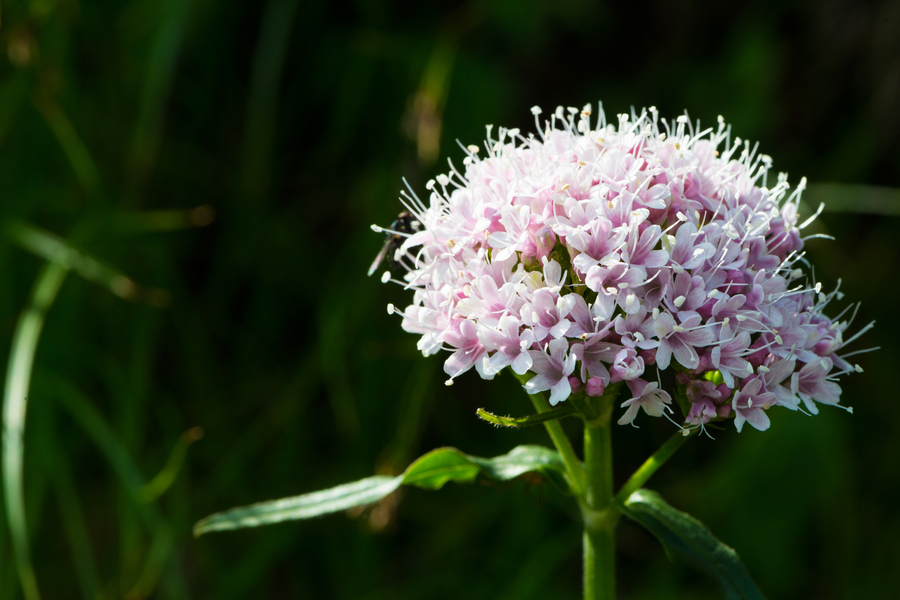
| Common name | Garden heliotrope, garden valerian, all-heal |
| Botanical name | Valeriana officinalis |
| Family | Caprifoliaceae |
| Plant type | Perennial, edible herb |
| Mature size | 3 to 5 feet in height and 2 to 4 feet wide |
| Growth rate | Rapid |
| Growth habit | Clump forming, erect |
| Maintenance | Medium |
| Native range | Europe, Asia |
| USDA hardiness zone | 4a, 4b, 5a, 5b, 6a, 6b, 7a, 7b |
| Ornamental plant value | Fragrant flowers attract bees, butterflies, and hummingbirds |
| Sun | Full sun (more than 8 hours of daily sunlight is essential for healthy growth and flowering) |
| Water | Once a week, watering is vital for fuller growth |
| Temperature | 90 to 100 degrees Fahrenheit |
| Soil | Occasionally dry and well-draining soil |
| Propagation | Root division, seeds |
| Garden and landscape use | It is perfect for butterfly gardens, flowering borders, and container plant |
| Toxicity | Non-toxic plant (the oil extracted from its leaves and roots is used as a condiment in ice cream and baking. |
Valerians are beautiful perennial flowers that start with V. They thrive best in a full-sun location, moist, fertile, and well-draining soil. Their herbs are edible. They spread through rhizomes and prefer cool weather conditions with frequent rainfall.
It is grown for its beautiful, fragrant flowers and soothing properties of the drug Valeria obtained from its roots.
2. Veronica (Veronica spp.)
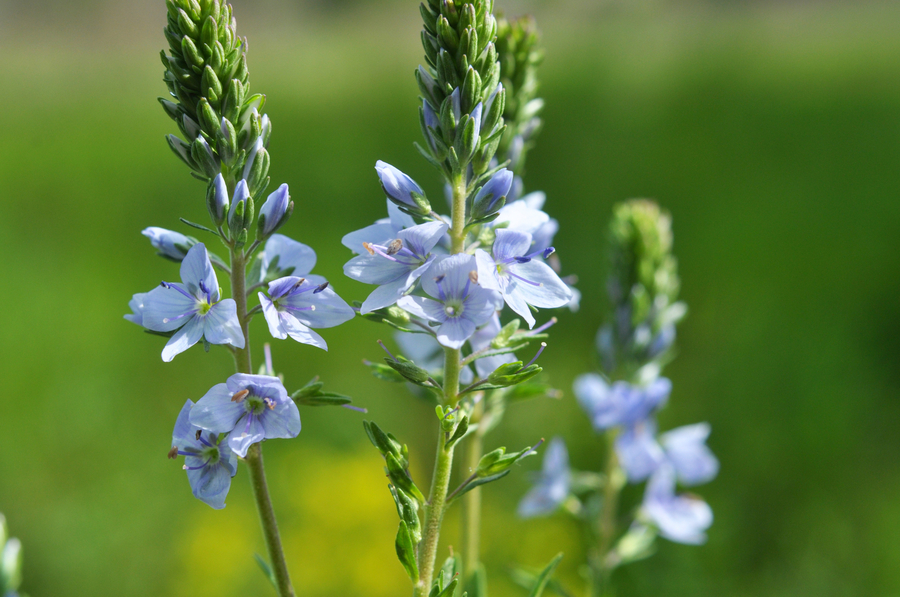
| Common name | Speedwell, veronica |
| Botanical name | Veronica spp. |
| Family | Plantaginaceae |
| Plant type | Perennial |
| Mature plant | Grows to a mature height of 1-4 feet with 1-2 feet spread |
| Growth rate | Medium |
| Growth habit | Horizontal, erect |
| Maintenance | Low |
| Native range | Russia, Europe |
| USDA hardiness zone | 3a, 3b, 4a, 4b, 5a, 5b, 6a, 6b, 7a, 7b, 8a, 8b, 9a, 9b |
| Sun | Full sun (6-8 hours of sunlight) |
| Water | Apply one inch of water every week to keep the roots hydrated |
| Temperature | 65 to 80 degrees Fahrenheit |
| Soil | Fertile, moist, and well-draining soils do wonders for the growth of speedwell plant |
| Propagation | Division, stem cuttings, seed |
| Ornamental plant value | Exquisite flowers that attract pollinators and butterflies |
| Bloom time | Spring, Summer, Fall |
| Flower color | An array of blue, purple/lavender, pink, and white |
| Garden and landscape use | Cut flower, edging, ground cover, and mass plantings in summer gardens, rock gardens, pollinator garden |
| Toxicity | Non-toxic |
Veronicas are a stunning member of the Plantaginaceae family. Its flowers that start with V is admired among novice and expert gardeners for its low maintenance growth habit and showy flowers. The vibrantly colored small flowers are borne upright, slender racemes and stay from spring to fall.
Veronica spp. grow to a mature height of 1 to 4 feet tall with 1 to 2 feet spread. These plants make an excellent accent garden plant with its upright flowering racemes.
3. Vetch (Vicia spp.)
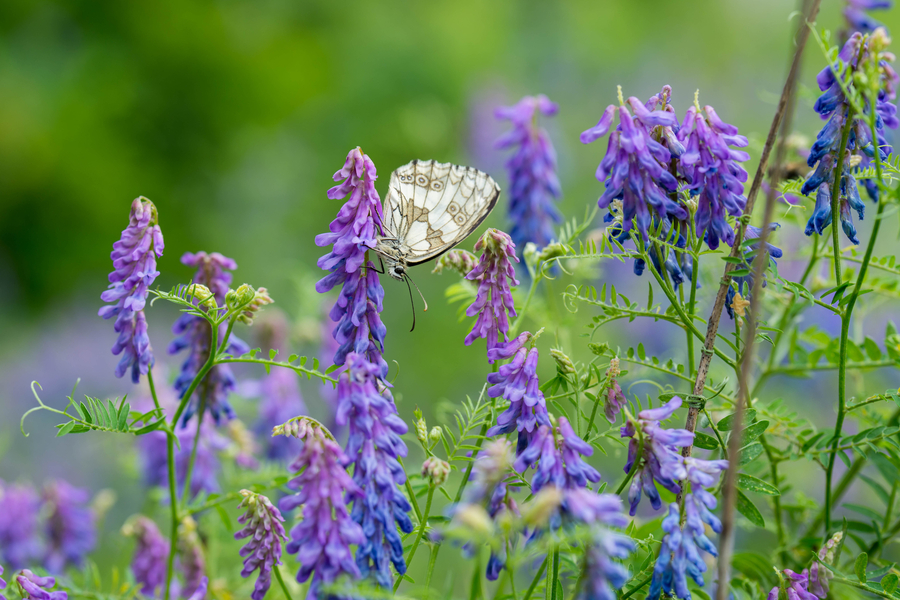
| Common name | Garden vetch, common vetch, golden tare |
| Botanical name | Vicia spp. |
| Family | Fabaceae |
| Plant type | Annual weed plant |
| Mature plant | 32 inches tall |
| Growth rate | Rapid |
| Growth habit | Climbing |
| Maintenance | Medium |
| Native range | Europe, North Africa, Asia |
| USDA hardiness zone | 2a, 2b, 3a, 3b, 4a, 4b, 5a, 5b, 6a, 6b, 7a, 7b, 8a, 8b, 9a, 9b, 10a, 10b |
| Sun | Full sun, partial shade (morning sunlight of 2-6 hours is best for these plants) |
| Water | Apply water once a week during the first growing season |
| Temperature | 65 to 85 degrees Fahrenheit |
| Soil | Moist, well-draining soil with neutral pH levels |
| Propagation | Seed |
| Ornamental plant features | Attracts the pollinators to home gardens with its purple/lavender flowers |
| Garden and landscape use | Edible home and pollinator garden |
| Toxicity | Low-severity poison characteristics |
Vetch plants are low-growing, winter annual weeds that belong to the Fabaceae family. They make excellent cover crops in fruit orchids for their creeping and semi-climbing growth habit. These plants are the favored food source of wild animals like deer, rabbits, and many other mammals. However, the only drawback of this plant in home gardens is its invasive tendencies.
These plants become weeds by competing with other plants for nutrients and water.
4. Violet (Viola spp.)
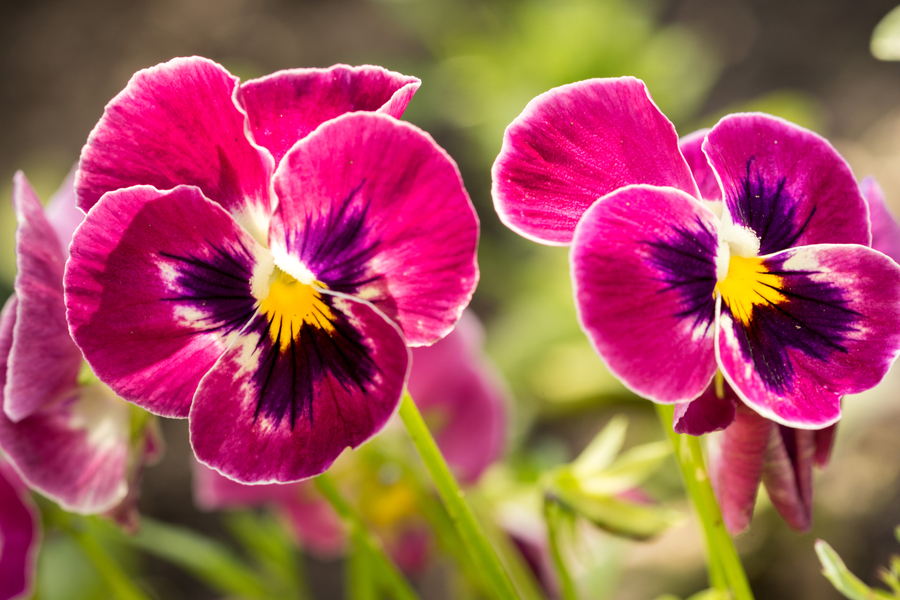
| Common name | Common blue violet, meadow violet, wild blue violet, purple violet, wood violet, wooly blue violet |
| Botanical name | Viola spp. |
| Family | Violaceae |
| Plant type | Native plant, perennial |
| Mature plant | 5-7 inches tall |
| Growth rate | Fast grower |
| Growth habit | Clumping |
| Native range | North America, Europe, Canada |
| USDA hardiness zone | 1a, 1b, 2a, 2b, 3a, 3b, 4a, 4b, 5a, 5b, 6a, 6b, 7a, 7b, 8a, 8b, 9a, 9b, 10a, 10b |
| Maintenance | Low |
| Sun | Dappled sunlight (shade through the upper canopy) |
| Water | Apply regular water throughout the growing season |
| Temperature | 40-70 degrees Fahrenheit |
| Soil | Nutrient-rich, moist, and well-draining soil |
| Propagation | Stem cutting, seed, division |
| Ornamental plant value | Beautiful flowers with five petals and appear fan-like that attract butterflies, bees, songbirds, small mammals |
| Garden and landscape use | Mass planting, butterfly, pollinator, and edible garden |
| Bloom time | Spring |
| Toxicity | Non-toxic |
Violas are distinct garden plants, including pansies, violets, and johnny-jump-ups. These are the fast-growing plants with flowers and leaves emerging on separate stems from rhizomes from March to June.
They are herbaceous perennials with edible flowers and appear year after year because of self-seeding. Violas bloom in spring and display gorgeous fan-like, five-petaled yellow, blue, pink, and purple/lavender flowers.
5. Virgin’s bower (Clematis virginiana)
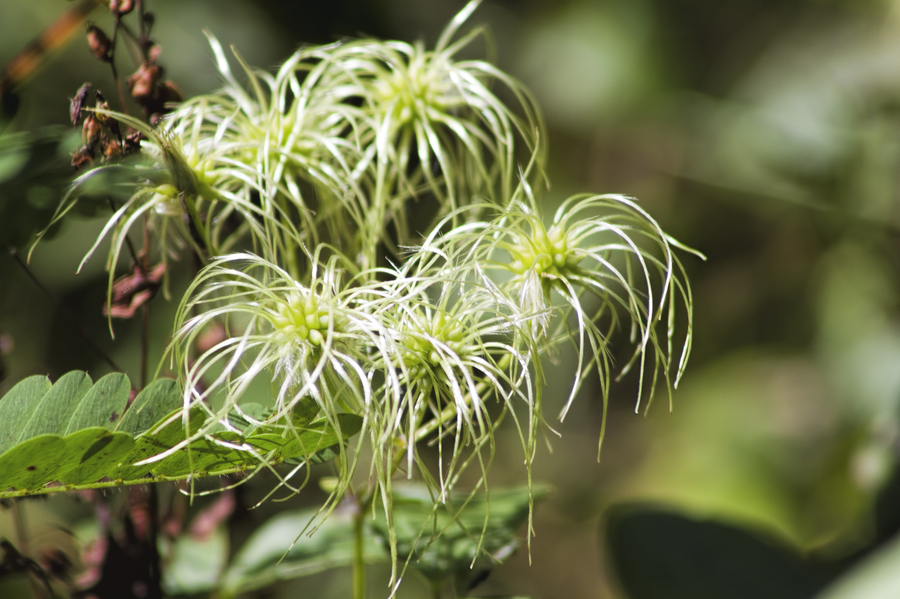
| Common name | Leather flower, devil’s darning needles, American virgin’s bower, woodbine, old man’s beard |
| Botanical name | Clematis virginiana |
| Family | Ranunculaceae (buttercup family) |
| Plant type | Perennial ground cover |
| Mature plant | 15 to 20 feet tall and 3-6 feet wide |
| Growth rate | Rapid |
| Growth habit | Climbing, spreading |
| Maintenance | Low |
| Native range | United States |
| USDA hardiness zone | 6a, 6b, 7a, 7b, 8a, 8b |
| Sun | Deep shade, partial sun |
| Water | Average |
| Soil | Moist and well-draining soils that are rich in organic matter |
| Temperature | Warm temperatures |
| Propagation | Seed, stem cutting, layering |
| Garden and landscape use | Rock garden, shade garden |
| Toxicity | Medium severity poison toxicity |
Virgin’s bower is a fast grower, climbing perennial that belongs to the buttercup family. These fast-growing perennial flowers that start with V reach a mature height of 12 to 30 feet within a few years and produce intensely fragrant blooms that emerge in autumn.
5. Virginia bluebells (Mertensia virginica)
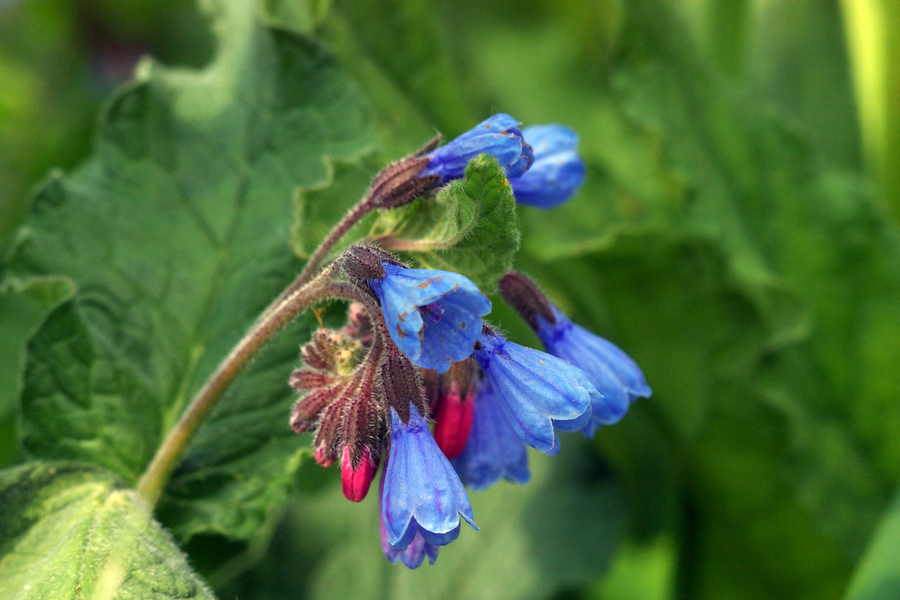
| Common name | Virginia bluebells, Eastern bluebells, chiming bells, blue and pink ladies, Virginia cowslip |
| Botanical name | Mertensis virginica |
| Family | Boraginaceae |
| Mature plant | 1-2 feet tall and 1-foot wide |
| Plant type | Herbaceous perennial |
| Growth rate | Medium |
| Growth habit | Clumping |
| Native range | North America |
| USDA hardiness zone | 3a, 3b, 4a, 4b, 5a, 5b, 6a, 6b, 7a, 7b, 8a, 8b, 9a, 9b |
| Maintenance | Medium |
| Sun | Deep shade, partial sun |
| Water | Medium |
| Soil | Moist, fertile, and well-draining |
| Temperature | 70-85 degrees Fahrenheit |
| Propagation | Root division, stem cuttings, seeds |
| Garden and landscape use | Mass planting, pollinator garden, cottage garden |
| Ornamental plant value | Showy flowers attract pollinators and hummingbirds |
| Toxicity | Non-toxic |
Virginia bluebells are the most beautiful native wildflowers that are easy to grow and maintain. They are herbaceous perennials with terminal clusters of trumpet-shaped flowers (about 1 inch in size) that appear in spring. Flower buds are pink, and flowers are blue with a pinkish cast.
They prefer part-shade locations to flourish successfully. Their active growing season is spring. In early spring, they emerge from the ground in small clumps and grow up to 2 feet tall.
The foliage is purple during the initial growth stages. Later it changes into bluish-green color quickly. By the mid-summer, the foliage dies as the plant enters the dormant state.
6. Virginia spiderwort (Tradescantia virginiana)
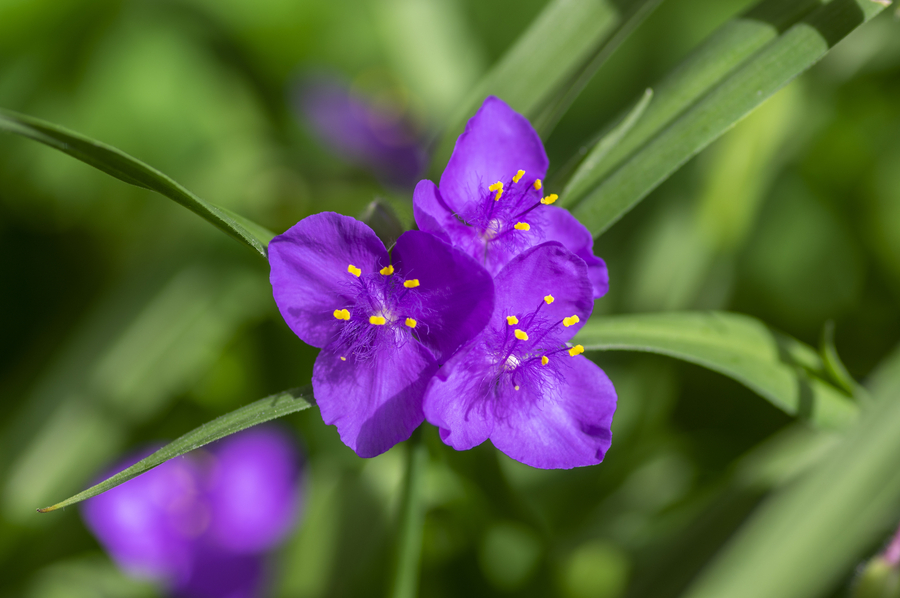
| Common name | Common spiderwort, Virginia spiderwort, spider lily |
| Botanical name | Tradescantia virginiana |
| Family | Commelinaceae |
| Plant type | Perennial native plant |
| Mature plant | 1-3 feet tall and 1-foot wide |
| Native range | Eastern and Central United States |
| USDA hardiness zone | 4a, 4b, 5a, 5b, 6a, 6b, 7a, 7b, 8a, 8b, 9a, 9b |
| Growth rate | Medium |
| Growth habit | Clumping, spreading |
| Maintenance | Medium |
| Sun | Deep shade, partial shade |
| Water | Medium |
| Soil | It grows best in soil conditions but must be well drained. |
| Temperature | 65 to 85 degrees Fahrenheit |
| Propagation | Cuttings, division, seed |
| Garden and Landscape use | Shade garden, native garden |
| Bloom time | Spring, Summer, and Fall |
| Toxicity | Non-toxic |
Virginia spiderwort is a clump-forming, herbaceous perennial in the dayflower family. These plants grow through underground rhizomes and reach a mature height of 2 to 3 feet in a few years. In spring, 3-petaled flowers appear in blue to purple colors, lasting only a day.
These stunning flowers attract pollinators because of their rich source of nectar. Hence, they are ideal plants to bring pollinators to home gardens.
6. Virginia sweetspire (Itea virginica)

| Common name | Virginia sweetspire, Virginia willow |
| Botanical name | Itea virginica |
| Family | Iteaceae |
| Plant type | Woody shrub |
| Mature plant | 4-8 feet tall and 3-6 feet wide |
| Native range | Southeastern United States |
| USDA hardiness zone | 5a, 5b, 6a, 6b, 7a, 7b, 8a, 8b, 9a, 9b |
| Growth rate | Medium |
| Growth habit | Rounded, arching, clumping |
| Maintenance | Medium |
| Sun | Partial shade, dappled sunlight |
| Water | Medium |
| Soil | Moist, well-draining soil |
| Temperature | 60 to 80 degrees Fahrenheit |
| Propagation | Seed, stem cuttings |
| Garden and landscape use | Pollinator garden, edging plant, mass plantings to control erosion |
| Bloom time | May and June with exquisite flowers, lasting for 4 to 6 weeks |
| Toxicity | Non-toxic |
Virginia sweetspire is a native, woody shrub that grows best in full sun to full shade locations and produces white blooms in terminal arching racemes.
6. Viper’s bugloss (Echium vulgare)
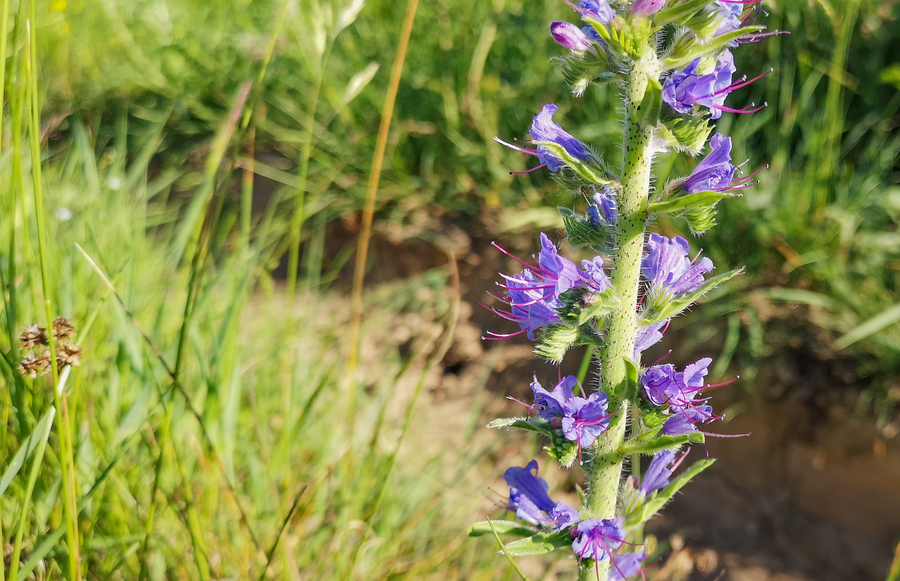
| Common name | North American blueweed, cat’s tail, blueweed, viper’s grass, blue thistle, adderwort, snake flower |
| Botanical name | Echium vulgare |
| Family | Boranginaceae |
| Plant type | Annual, Biennial, Perennial |
| Mature size | Grows to a mature height of 1-3 feet tall and 1-foot wide |
| Growth rate | Medium |
| Growth habit | Clumping, erect |
| Native Region | Southern Europe to North West Asia |
| USDA hardiness zone | 4a, 4b, 5a, 5b, 6a, 6b, 7a, 7b, 8a, 8b |
| Maintenance | Low |
| Sunlight | Full sun (it needs more than 6 hours of direct sunlight for best growth and blooming) |
| Soil | Well draining |
| Temperature | 95 to 105 degrees Fahrenheit temperature is ideal |
| Water | Once a week, specific water applications are perfect for these plants. |
| Propagation | Seeds |
| Garden and Landscape uses | Mass plantings in containers as long-season bloomers and looks excellent in drought-tolerant and cottage gardens. |
| Ornamental plant features | It offers showy blooms in blue, red/burgundy, and pink colors from spring to fall. Also, attract butterflies, bees, and hummingbirds. |
| Toxicity | It has medium-severity poison characteristics because of alkaloid crystals. |
Viper’s bugloss belongs to the borage family and is grown as annual, biennial, and perennial plants. When grown as a biennial garden plant, it produces the basal leaves in its first growing season, while the blooming will occur in the following year.
Its beautiful flowers that start with a V appear in different colors, including red, bright blue, and red/burgundy. The roots of this plant are used to treat snakebites.
Annual Flowers that Start with a V
1. Verbena (Verbena spp.)
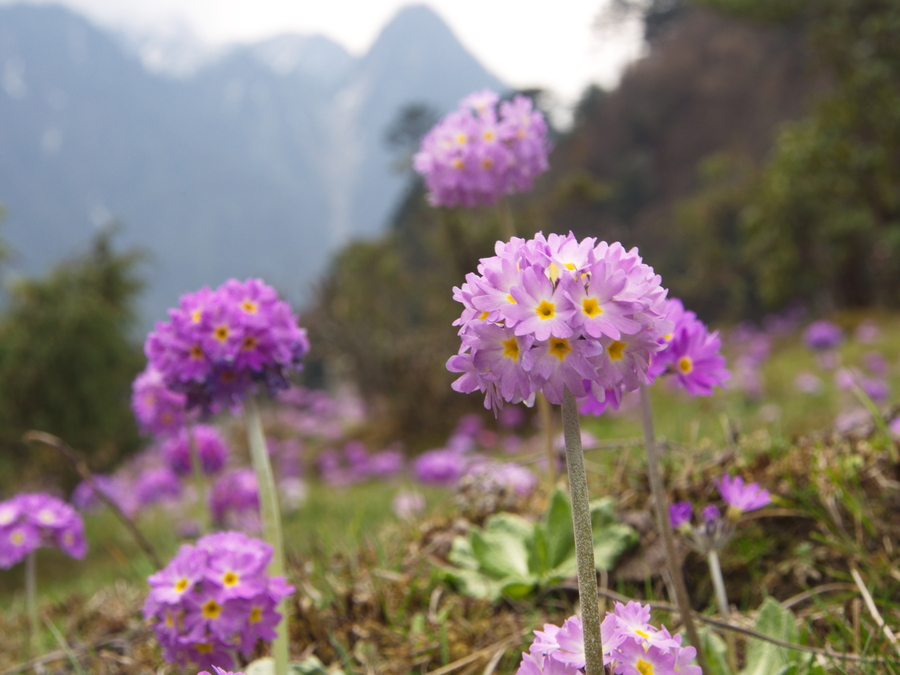
| Common name | Rose vervain, clump verbena, rosa verbena |
| Botanical name | Verbena spp. |
| Family | Verbenaceae |
| Plant type | Wildflower, herbaceous perennial, native plant |
| Mature plant | 1-foot tall and 1 to 2 feet wide |
| Native range | North America |
| USDA hardiness zone | 6a, 6b, 7a, 7b, 8a, 8b, 9a, 9b, 10a, 10b |
| Growth rate | Rapid |
| Growth habit | Mounding, spreading |
| Maintenance | Medium |
| Sun | Full sun |
| Water | Medium |
| Soil | Well-drained, sandy loam soil |
| Temperature | 60 degrees Fahrenheit is the ideal temperature range for these plants |
| Propagation | Seeds |
| Garden and landscape use | Butterfly, native, rock, and cottage gardens |
| Toxicity | Non-toxic |
Verbena plants are low-growing herbaceous perennial flowers that start with V that like to expand on dry soils and full-sun locations. They produce clusters of tiny flowers in pink to purple colors that last from spring to fall. When these plants are grown in home gardens, they need regular pinching and pruning for compact size.
2. Venus’ looking glass (Triodanis perfoliata)
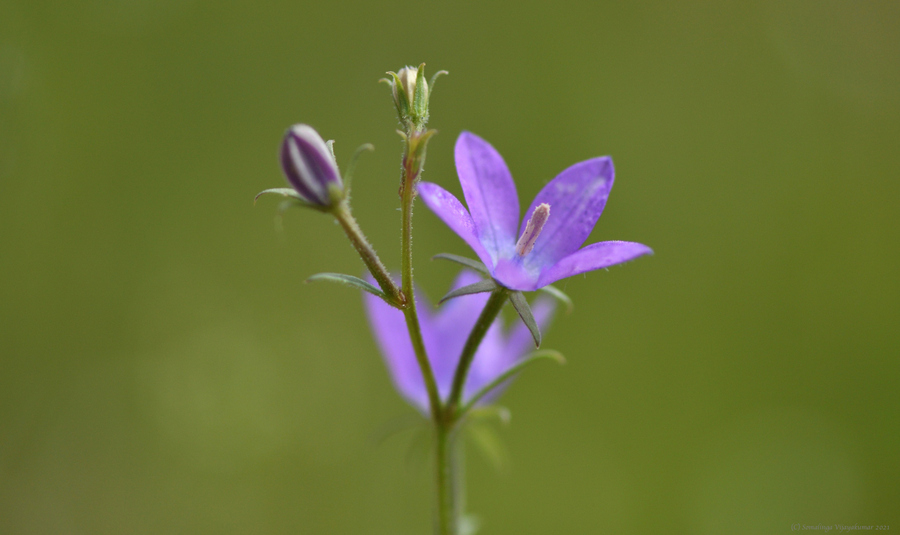
| Common name | Clasping bellflower, Venus’ looking glass, clasping bellwort, small Venus’ looking glass |
| Botanical name | Triodanis perfoliata |
| Family | Campanulaceae |
| Mature plant size | 12-30 inches tall |
| Plant type | Annual, herb |
| Native range | Mexico, South America |
| USDA hardiness zone | 2a, 2b, 3a, 3b, 4a, 4b, 5a, 5b, 6a, 6b, 7a, 7b, 8a, 8b, 9a, 9b, 10a, 10b, 11a, 11b |
| Growth rate | Medium |
| Growth habit | Erect |
| Maintenance | Medium |
| Sun | Full sun (6-8 hours of direct sunlight is ideal for best growth) |
| Water | Average |
| Soil | Occasionally dry and well-draining soil |
| Temperature | 95 to 105 degrees Fahrenheit |
| Propagation | Seed |
| Garden and landscape use | Native and pollinator garden |
| Bloom time | Spring, Summer |
| Toxicity | Non-toxic |
Venus’ looking glass are native annual flowers that start with V in the bellflower family. It grows best in full-sun locations and well-draining soils. This plant blooms in spring and summer, producing five-petaled flowers in pink, blue, and purple/lavender colors.
3. Vinca (Catharanthus roseus)
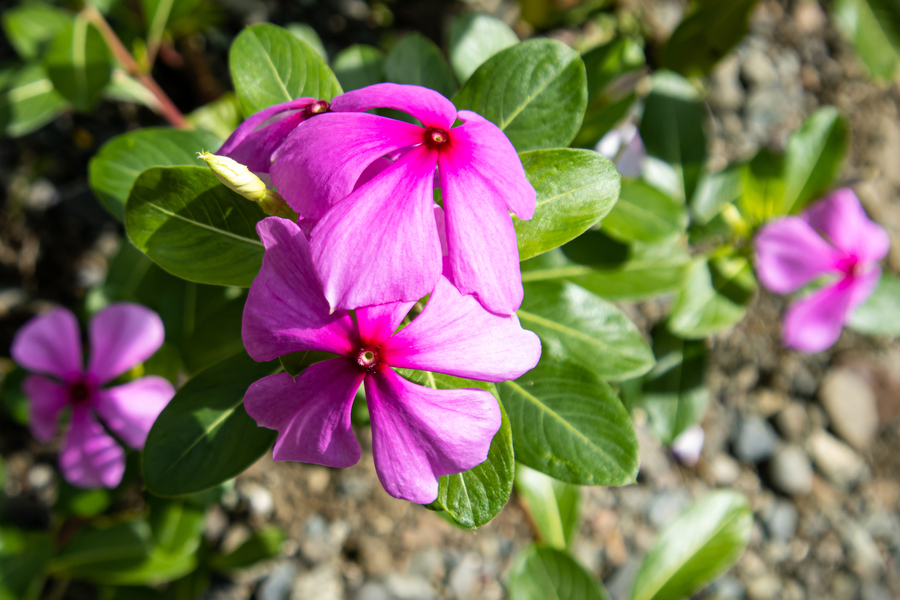
| Common name | Annual vinca, periwinkle, rose periwinkle, Madagascar periwinkle, vinca, running myrtle |
| Botanical name | Catharanthus roseus |
| Family | Apocynaceae |
| Mature plant size | 6 inches to 1 foot tall and 8-10 inches wide |
| Plant type | Annual ground cover |
| Native range | Madagascar |
| USDA hardiness zone | 10a, 10b, 11a, 11b |
| Growth rate | Fast |
| Growth habit | Spreading, erect |
| Maintenance | Low |
| Sun | Dappled sunlight |
| Water | Average |
| Soil | Well draining |
| Temperature | 65-85 degrees Fahrenheit |
| Propagation | Seed |
| Garden and landscape use | Pollinator garden, drought tolerant garden |
| Bloom time | Summer, Fall |
| Flower color | White, gold/yellow, pink, purple/lavender |
| Toxicity | Low-severity poison characteristics |
Vinca is an evergreen, cold, tender, herbaceous plant grown as an annual or indoor houseplant in colder climates. Its flowers that start with V grow best in various soil conditions, including clayey and sandy loam soils.
Vinca plants are long-season bloomers, from mid-July to September or until the season’s first frost. They do not need deadheading or pinching and can sustain heat stress.
Frequently Asked Questions (FAQ) on Flowers that Start with V
What are the yellow flowers that start with the letter V?
The garden pansy (Viola x wittrockiana) are hybrid flowers that start with a V with distinct yellow flowers.
What flowers that bloom in the summer start with a “V”?
Here’s a list of flowers that start with a V and bloom in the summer: verbena, viola, Venus’ looking glass, vinca, Virginia bluebells, and Virginia spiderwort.
What are some yellow tropical flowers that start with a V?
Viola ‘Dawn’ and Verbascum offers bright yellow flowers that start with the letter V. These flowers last from spring to fall.
Image credit: Depositphotos; Wikimedia; Flickr
